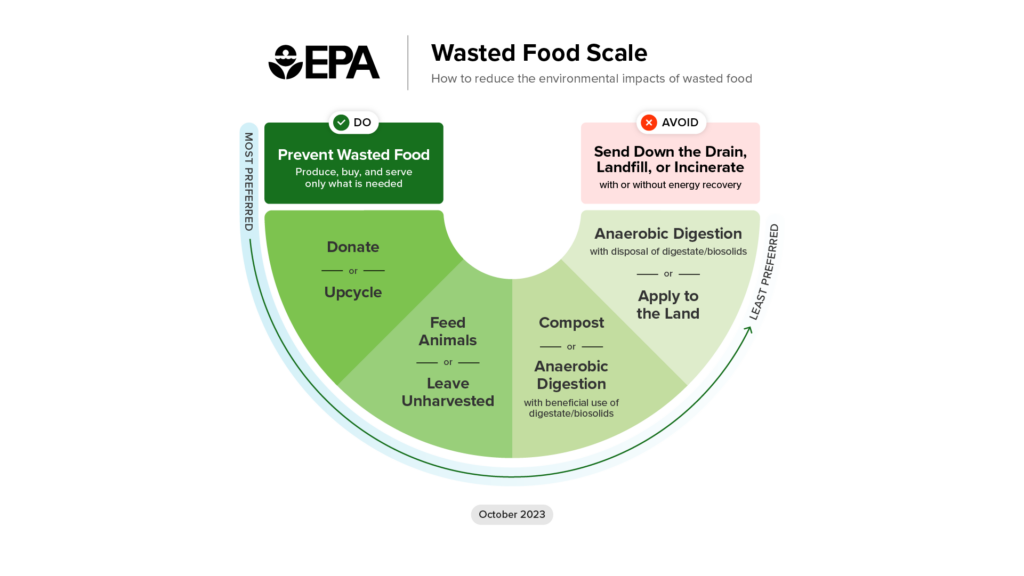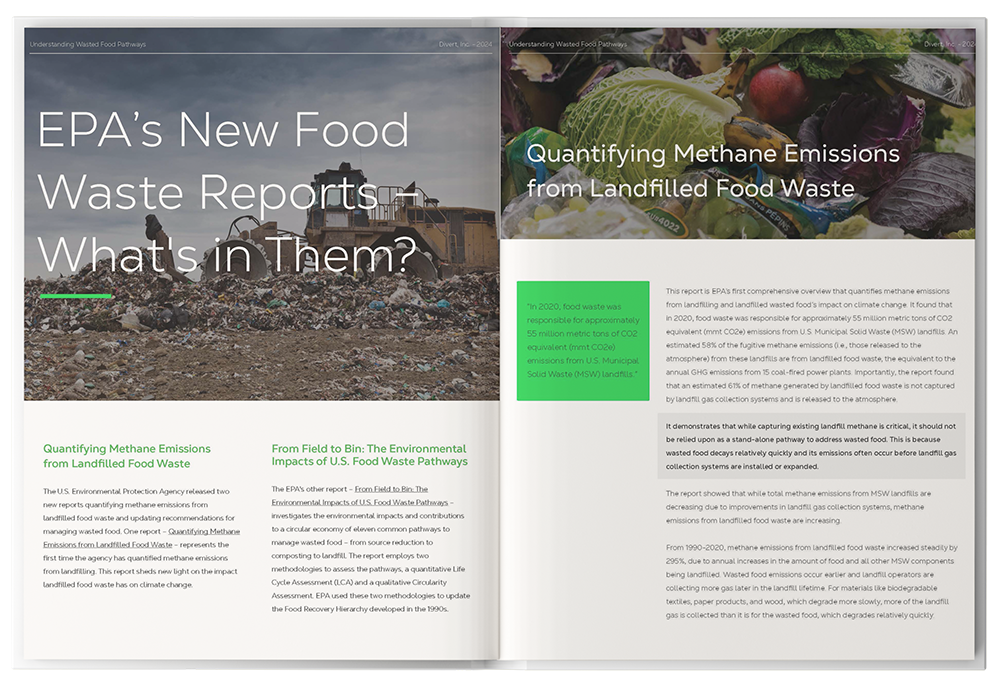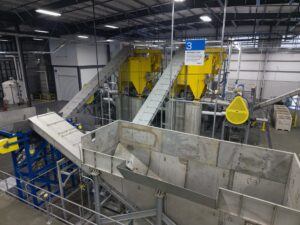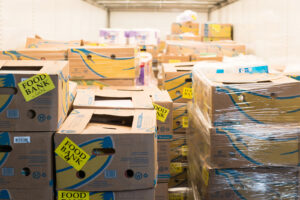August 1, 2024
In this blog: Why Does Food Go to Waste? | How Food Waste Impacts the Environment | How Food Waste Impacts Food Insecurity | Managing Wasted Food with Sustainable Pathways | Scaling Wasted Food Prevention
Summary: This post takes a close look at the deeply interconnected issues of food insecurity and the climate crisis, both negatively impacted by wasted food around the world. By preventing and diverting wasted food from landfills, we can begin to solve both food insecurity and climate change.
A recent report from the United Nations shows the staggering impact of wasted food on two interconnected crises: global food insecurity and climate change. According to the UN, more than one billion meals are wasted across the world each day while 800 million people go hungry. Nearly a fifth of all food produced goes into landfills around the world, generating roughly 8-10% of global greenhouse gas emissions.
The UN’s report isn’t the first of its kind, but these latest numbers underscore the urgent need to change our waste management practices to reduce these social and environmental harms. In this post, we’ll take a deeper look at the complex issue of wasted food: why it happens, how it impacts food security and the environment, and the multi-pronged approach needed to address it at scale.
Why Does So Much Food Go to Waste?
Food is wasted all along the supply chain, from the fields where raw materials are grown, to the plate where it is eaten (or thrown away). The biggest single stream of wasted food comes from households, making up nearly 48% of all food waste in landfills, while the other ~52% happens across several business sectors from farming (16.8%) and manufacturing (14.7%), to consumer-facing businesses (20.2%) such as retail grocers and food service settings.
Inefficient ordering systems and management processes contribute to the overall problem, along with outdated waste management infrastructure that provides limited options for handling food waste once it’s in the bin and taken offsite. (For more on how and why food is wasted on a commercial scale, visit this post.)
A certain amount of food waste is inevitable when the possible uses for uneaten or unsold food become limited (think: plate waste at a restaurant), but that doesn’t mean that there are no good options to reclaim value from that wasted food. A paradigm shift is needed around what we do with that wasted food, from a linear economy that sends uneaten and unsold food to the landfill, to a circular economy where all edible food is given to those who need it, and inedible food is treated as a renewable resource. Wasted food is an area ripe for innovation that, if handled correctly, can feed more people and prevent further harm to the environment.
How Food Waste Impacts the Environment
Food waste represents several negative impacts to the natural environment, upstream and downstream:
- Upstream, it wastes the resources used to produce the food: land use, water, energy, human labor, packaging materials, and contributes harmful emissions from harvesting and shipping. This strains the natural resources we have available to continue growing food into the future.
- Downstream, food waste makes up 8-10% of global greenhouse gas emissions. The vast majority of food waste goes to landfills, where it generates methane as it breaks down. A potent greenhouse gas, methane has about 80 times the warming power of carbon dioxide over the first 20 years.
Prevention of wasted food upstream is key to protecting natural resources for future food production, while downstream diversion is key to preventing the harmful emissions that make the climate more hostile to agriculture.
How Food Waste Impacts Food Insecurity
In the U.S. it has been estimated that nearly 63 million tons of food goes to waste annually, or nearly 40%, while 44 million people are food insecure. When edible food ends up in the landfill, it prevents access to affordable, nutritious food. It represents a lost opportunity to feed those who are food insecure at the local level.
An impact of food waste that may be less obvious to the average consumer is its impact on food affordability. Food waste drives up food prices, causing inflation, and this happens in two ways:
1 – As mentioned above, wasted food strains natural resources needed to grow more food, which leads producers and manufacturers to increase prices.
2 – Inefficiencies within the food system that lead to wasted food can cause producers and manufacturers to increase their prices to accommodate the lost revenue. When food is ruined, lost, or discarded in the process of growing, producing, and distributing, then the producers will raise the price on the remaining food to protect their profitability.
These factors ultimately increase the cost of food available to everyone, the impact of which is felt most acutely by those who are low income.
A 2021 report from the EPA, From Farm to Kitchen: The Impacts of US Food Waste, confirms that food insecurity is not a problem of scarcity. According to the EPA report, the amount of wasted food “is sufficient to feed 154 million people per year, a far greater number than estimated by the USDA to be food insecure.”
At Divert, we are addressing the food insecurity problem through infrastructure and data: when businesses, like retail grocers, are given more visibility into their wasted food volumes and more training support for their employees on how to manage edible, unsold food, they can optimize their donation programs to distribute edible food at the local level.
Managing Wasted Food with Sustainable Pathways
While the statistics from the UN’s report are alarming, they present a clear and urgent opportunity to have a dual impact on our environment and society by addressing wasted food. Businesses in the food industry, from retail grocers to producers, manufacturers, distributors, and restaurants, have an important role to play in preventing waste upstream and diverting it downstream. Yet, we know that prevention of wasted food on a commercial scale is complex, and it can be difficult for businesses to know how to begin to tackle this problem. Consideration needs to be given to program costs; existing business operations; ESG goals; local, state, and federal regulations; and the total climate impact of the solutions available.
In October 2023, the EPA published a new food waste report and Wasted Food Scale, which assesses and ranks different wasted food pathways based on environmental impact and circularity. The EPA Wasted Food Scale prioritizes Prevention and Feeding Others over recycling pathways: any food that is edible and able to be donated should be given to those who need it most.

Yet, some amount of wasted food is inevitable, and for inedible food, sustainable pathways such as composting or anaerobic digestion are key to preventing landfill waste. Which pathway is the right fit for commercial businesses – composting, or anaerobic digestion? A closer look at the EPA’s new Wasted Food Scale establishes anaerobic digestion as the strongest performing pathway after Prevention and Feeding Others, making it an ideal diversion tactic for scaling wasted food reduction at commercial and industrial levels. Although composting is a good solution for household wasted food where it can be mixed with yard waste in small quantities, there are major challenges to composting on a commercial scale, from moisture levels to depackaging to avoid contamination. Anaerobic digestion, on the other hand, is a preferred method for processing non-donatable wasted food on a commercial and industrial scale, both for its efficiency and for its ability to generate environmentally beneficial byproducts, such as biogas and beneficial digestate.
Our analysis of the EPA Wasted Food Scale shows that Divert’s facilities deploy almost all of the EPA’s preferred pathways:
- Providing actionable data and insights to enable more informed purchasing decisions that reduce and prevent wasted food.
- Deploying insights and technology to improve customer donation efforts, including facilitating donations directly at our Food Recovery Center.
- At certain facilities, sending wasted food to animal feed and compost.
- At our current facilities and future Integrated Diversion & Energy Facilities, producing:
- Renewable energy through anaerobic digestion, a process with more beneficial environmental impacts than composting.
- Digestate that is reintroduced back into the agricultural supply chain as a soil amendment for composting, fulfilling critical circularity goals and addressing resource scarcity.
With this approach, we’re able to address and mitigate the hunger crisis and the climate crisis at the same time by ensuring that food, whether edible or inedible, is sent to its best and highest use.

Learn More:
Get a full analysis of the EPA’s Wasted Food Scale in our free whitepaper. Learn to make informed choices about waste diversion now!
Scaling Wasted Food Prevention
It will take everyone doing their part – individuals as well as commercial businesses – to reduce wasted food if we want to make progress on food security and climate change.
With 17 years of experience in wasted food diversion for commercial businesses, Divert understands how complex this effort can be, and we’ve worked with our customers to build and optimize diversion programs at scale.
As the leader in wasted food diversion, we have processed over 2.6 billion pounds of wasted food, significantly reducing the amount of food sent to landfills, and helped our customers donate over 14+ million meals to the food insecure. In 2023, we processed over 384 million pounds of wasted food over twelve months, mitigating approximately 35 thousand metric tons of greenhouse gasses. Each of our new Integrated Diversion & Energy Facilities will have the capacity to process 200 million pounds of wasted food per year.
Divert’s solutions are designed to help our customers manage the complexity of wasted food prevention and diversion, with:
- Nationwide infrastructure
- Depackaging technology
- RFID tracking for store-specific data collection
- Reverse logistics or pickup services, depending on business operations
- Enabling compliance to local, state, and federal regulations like SB 1383 in California and HB 2301 in Washington state
Divert has the resources and experience to optimize diversion programs and ensure customers are making a lasting impact on the environment and society through sustainable change. Learn more about our solutions today.



